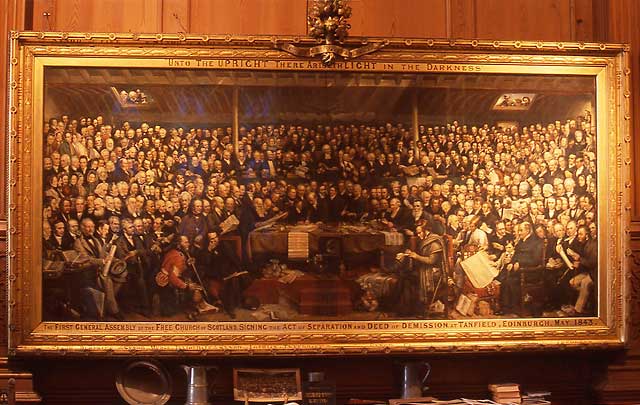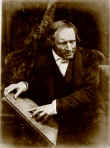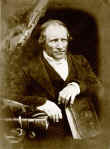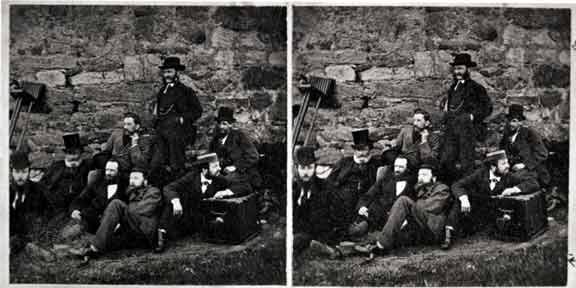|
Rev Alexander Keith Father of two members of the Photogrpahic Society of Scotland George Skene Keith and Thomas Keith |
|
Rev Alexander Keith Rev Alexander Keith was father of the eminent surgeons, George Skene Keith and Thomas Keith who set up a private hospital in Great Stuart Street, Edinburgh [MIT] Both were also photographers and members of the Photographic Society of Scotland. Rev Alexander Keith was one of the Ministers featured on David Octavius Hill's painting of the 1843 Disruption of the Church of Scotland, where Ministers broke away to form the Free Church of Scotland. Reproduced with acknowledgement to the Free Church of Scotland © Photographed by peter.stubbs The photographs of Rev. Dr. Alexander Keith above are calotypes taken by Hill & Adamson around 1843. |
|
Religious Book Rev Alexander Keith wrote: 'Evidence of the Truth of the Christian Religion' His son, George Skene Keith provided the daguerreotypes that were used as the basis for the illustrations in this book in 1846. |
|
1. George Skene Keith |
|
|
Medicine George Skene Keith was a member of Sir James Young Simpson’s Research Team that pioneered the use of chloroform as an anaesthetic. |
|
|
Photography George Skene Keith was a Founding Member of the Photographic Society of Scotland, and a keen daguerreotypist. Here is an extract from a recent response that Prof. John Hannavy gave to questions asked about George Skene Keith. John wrote: |
|
|
Books "I am currently in the process of updating and expanding my 1981 biography of Thomas Keith to embrace the work of both his elder brother, George Skene Keith, and his brother-in-law John Forbes White. I live in hope that this will be published late next year (2013). Travel to Palestine When? George Skene Keith may have been the first Briton to travel to the Holy Land with a camera, but despite the assertions of the British Journal of Photography below*, he was not the first photographer to take pictures in Palestine, Jordan and Syria. Fréderic Goupil-Fequet, who visited in December 1839, only weeks after Daguerre’s announcement of the process, was almost certainly the first. Some confusion exists over exactly when the Keith's first photographic journey took place. Editions of Dr. Keith’s book from the late-1840s imply that it was during his first, 1839, expedition sponsored by the Church of Scotland – of which he was then still a minister – but, despite some quite convincing clues, that seems highly unlikely. However, a measure of caution must be applied to recollections written even relatively few years after the event. The idea that Dr. Keith might have been tutored on the calotype as early as spring 1839 is impossible as the process was not invented by Talbot until a year later. Nor does any report of such experiments with photography appear in the several editions published between 1839 and 1847, but it is interesting to note, that he recalled that ‘the mode of preparing which was a still a secret’. If an 1839 date was to be believed, it would have been Talbot’s earlier Photogenic Drawing process – and as that was so slow as to be wholly impractical, failure would have been unavoidable. John added: Daguerreotypes Where are they now? "I've already exhausted every line of enquiry that I can think of in attempts to trace George Skene Keith’s daguerreotypes, but have not been able to trace them. George Skene Keith showed a number of them to a meeting of the Edinburgh Photographic Society in late-1876 and later exhibited them at the EPS Exhibition which ran from December 1876 into early 1877. The 'British Journal of Photography' reported:
Prof. John Hannavy: November 28, 2012 |
|
|
Where are the Daguerreotypes? If you have any idea where George Skene Keith’s daguerreotypes might be now, please email me, then I'll pass on your message to John Hannavy. Thank you. Peter Stubbs, Edinburgh: November 29, 2012 |
|
2. Thomas Keith 1827-1895 |
|
Reproduced
by courtesy of Edinburgh City Here is a stereo pair of prints of a Photographic Society of Scotland outing to Craigmillar Castle, Edinburgh, in 1856. John Hannavy, who researched the work of Thomas Keith believes that Thomas Keith may be one of the members of this group. [TKS] |
|
Thank you to Shelley McKinney who wrote: Thomas Keith "I recently purchased a booklet 'Thomas Keith 1827-1895 Surgeon and Photographer' [The Hurd Bequest: Edinburgh Corporation Libraries and Museums Committee, 1966].' This booklet includes a copy of this photograph of Members of the Photographic Society of Scotland on a photographic outing: The booklet says 'Though the figures are not identified, there is a strong resemblance between the hatless gentleman seated against the wall and Thomas Keith, and the foreground camera is of the size and type which was used by him.' " Shelley McKinney, Sacramento, California, USA: September 5, 2008 |
|
Thomas Keith |
|
Early Years Thomas Keith was educated at Aberdeen, studying Art at Marischal College, Aberdeen. In 1845, he became Medical Apprentice to Sir James Young Simpson |
|
Photography 1853-56 Based on the dates recorded on his negatives, it appears that Thomas Keith took most of his photographs between 1853 and 1856. He used a camera with a single achromatic lens of 17 inch focus and 5/8 aperture. The camera had a maximum image area 11 ins x 10 ins. He reported that his exposures ranged from 2 to 8 minutes, depending on the circumstances. His photography appears to have come to an end around 1857. From then on, he devoted more time to his medical commitments, and became an eminent surgeon. [Edinburgh Library Exhibition] |
|
Pictorial Photography Thomas Keith was brother in law of John Forbes White whom he met at school. Both knew David Octavius Hill; all three having an interest in painting which gave their photography a strong pictorial quality. [MIT] Thomas Keith took many views of Edinburgh, particularly in the early morning. He took photographs only when the light was good. He said: "If you were to ask me to what circumstances more than any other I attribute my success, I should say that I never expose my paper unless the light is first rate." He was a pioneer of the waxed paper process and produced attractive views of the empty streets of Edinburgh lit by the low sun with long shadows. |
|
PSS Member Thomas Keith was a Founding Member of the Photographic Society of Scotland in 1856, and a Member of its Council in 1856 and 1857. He delivered a Paper to the Photographic Society of Scotland on 10 June 1856. |
|
Thomas Keith Further Research |
|
Seminar The Scottish Society for the History of Photography held a one-day seminar on Thomas Keith and his photography, in Edinburgh Central LIbrary in November 24, 2006. The society plans to do more in the coming months to bring Keith's work to a wider audience. |
|
Photographs and Negatives in Collections The Edinburgh Room at Edinburgh Central LIbrary has a collection of Keith's negatives and photographs. Where else can his work be found? Prints and negatives by Thomas Keith, can also be found at: - Scottish National Portrait Gallery - Royal Scottish Academy - National Museum of Photography, Film and Television - Canadian Centre for Architecture - George Eastman House - Harry Ransom Centre John Hannavy wrote the book, The Victorian world of Dr Thomas Keith and John Forbes White, published in 1981, and hopes to complete his latest book on the Keith Brothers and John Forbes White in late-2013. John also has several negatives that he believes may well have been taken by Keith. However, no definitive catalogue of Keith's work has ever been published. Thank you to Roddy Simpson and John Hannavy for providing the list above. |
|
Request for Help If you know of any other negatives of photos by Thomas Keith, or of any correspondence to or from Thomas Keith, please e-mail me and tell me about it. Thank-you. Peter Stubbs, December 10, 2006. |




